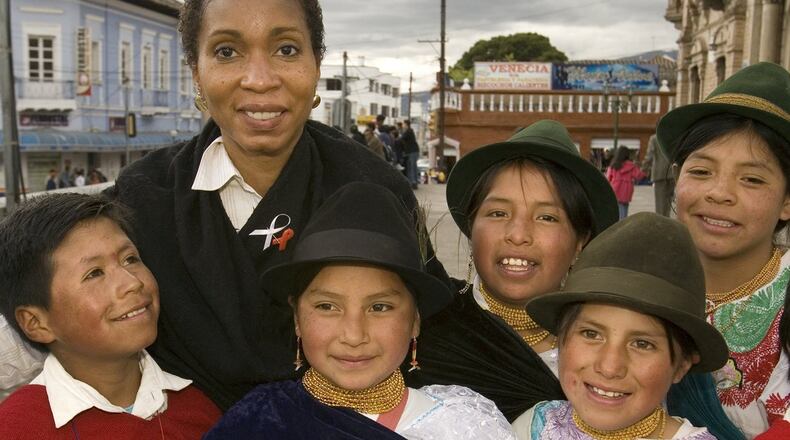INSPIRING PERSPECTIVES
Each Sunday, the AJC brings you insights from metro Atlanta’s leaders and entrepreneurs. Henry Unger’s “5 Questions for the Boss” reveals the lessons learned by CEOs of the area’s major companies and organizations. The column alternates with Matt Kempner’s “Secrets of Success,” which shares the vision and realities of entrepreneurs who started their dreams from scratch.
Find previous columns from Unger and Kempner at our premium website for subscribers at www.myajc.com/business.
After nine years of dealing with natural disasters and poverty around the world, Dr. Helene Gayle will be leaving her job as chief executive of CARE USA next month.
Gayle, a trained pediatrician who had worked for the Centers for Disease Control and the Bill & Melinda Gates Foundation, took over the top job at Atlanta-based CARE in 2006. With programs in 87 countries and annual revenue of nearly $490 million, CARE’s mission is to fight poverty while also responding to the globe’s catastrophes, whether created by Mother Nature or a ruthless dictator.
Gayle, 59, talks about what she’s learned from a vantage point few leaders experience.
Q: Do you know how many crises you’ve been involved in?
A: There are crises and then there are crises.
The countries where we work are, unfortunately, more vulnerable to natural disasters, shocks and mudslides. We see them all the time — cyclones and small earthquakes that people don’t hear about and don’t know we’re responding to. There’s not a month that goes by where we aren’t involved in something like that.
Then there are huge catastrophic events like the recent earthquake in Nepal.
And there are security conflicts, like in Syria, Afghanistan, Burundi and South Sudan.
Q: How do you respond to a crisis? What can other leaders learn, whether they run a nonprofit or a major company?
A: There's probably more mistakes than lessons.
The main thing is being prepared, because we know there will be unforeseen shocks.
You have to have the infrastructure in place. We primarily respond in countries where we have a nearby infrastructure, like we do in Nepal.
Also, our staff is trained in crisis management. Everybody goes through training in our country offices.
And we put in a lot of time thinking about how you can bounce back better and quicker after a natural disaster strikes.
Q: How did you improve CARE’s infrastructure, which was lacking when you arrived?
A: Partnerships are key. How you pull together different partners with different assets is critical.
For example, our partnership with UPS upped our game. The logistic king of the world greatly helped us position emergency supplies for future use. They helped us build our inventory tracking system so we know what our inventory is and can respond more rapidly.
In the Nepal earthquake, for example, we had a good logistics capability in India, so we were able to get things over there relatively quickly.
Q: In addition to responding to disasters, CARE is charged with reducing poverty. What program comes to mind that’s been particularly effective?
A: Our mission is to help as many poor people around the world as possible.
One of the most tangible, life-changing programs is called Village Savings and Loans.
It’s very simple. People collect small amounts of money, pool it and provide resources for loans to start a business. Then they plow some of the returns back to provide more loans.
We help them structure their organizations and provide training.
Our big focus is on women. To see what having economic opportunity from a $2 or $3 loan does to changing the life of a woman and her family is remarkable.
Some of them were prisoners in their own home. With a small business, they start to have a sense of self-worth and the ability to contribute to putting food on their table and sending their children to school.
Their husbands no longer see them as a burden. The women gain greater respect at home and in the community.
Q: What was your reaction after observing that firsthand?
A: It doesn't get any better than to see people realize a sense of hope for the future.
Bonus questions
Q: But since poverty is so entrenched around the world, don’t you get discouraged?
A: It's important to keep the long view in mind.
I do believe we can eliminate extreme poverty in our lifetime. It’s possible to make sure that most people in the world have enough to eat, access to clean, safe drinking water, and access to health services and education.
We have the ability to do that. It will take a lot of things moving in the right direction — the will to do it and resources — for that to happen.
Q: What was one of your toughest decisions?
A: For some 60 years, CARE had a food monetization policy. U.S. farmers were subsidized for grain shipped overseas on American carriers. We at CARE used the money from the in-kind grain contribution for some of our programs.
But the U.S. grain was flooding the market overseas, essentially depressing the prices the local farmers could get there. We were hurting the people we were trying to help by undercutting agriculture in developing countries.
So starting in 2008, we stopped doing that and forfeited $50 million to $100 million a year. We decided it was the right thing to do in principle, even though it meant a huge financial hit.
There was blowback from that decision. But it allowed us to be work for food aid reform to increase local purchases from local farmers, so they could earn a living.
Q: Did you have an especially difficult moment in your job?
A: One of my hardest moments was when the financial challenges of the food monetization decision came at the same time as the recession, which created a perfect storm for us financially.
It was a time when we had to have a major restructuring, including layoffs.
It’s hard to let staff go who put so much of themselves into this mission. That was a very, very painful moment for me.
I think it made all of us better stewards of resources. We became more efficient.
Q: What was one of your biggest mistakes?
A: People decisions are the hardest issues to handle in organizations.
There are times when I look back and wish that I had thought about my people decisions earlier and quicker, because they can make a big difference. Now, for example, I spend more time on talent development.
Also, I’ve learned a lot more about giving a clear sense of what the expectations are and then holding people accountable by measuring their effectiveness.
At the same time, you have to motivate people and build teams.
Q: What’s your best advice for your successor, Michelle Nunn?
A: This can be a very overwhelming role, as running any large and complex organization can be. There are so many facets to it. You can get pulled in so many different directions.
But you can’t fix everything. This organization will never just be floating along on an even keel. There will always be ebbs and flows.
So it’s important to be clear and focused about what you want to accomplish early on. You need to focus on a few things and get them done well.
Also, I learned the hard way that you have to make sure the machine — the organization’s financial management, talent management and other functions — is running smoothly from an operational sense, so you can deliver on your mission.
Q: Any other advice for Nunn or other leaders?
A: There is balance between not taking yourself too seriously and making sure you're taking yourself seriously enough.
In any organization, what the leader does has a huge impact. People watch you. They pay attention to what you’re saying.
On the other hand, you shouldn’t lose the fun in the job and lose a sense of balance. If you do, you can become disconnected. You can find yourself in a bubble and lead the organization in the wrong direction.
Q: Why are you leaving now?
A: When I came in I felt that five years is the minimum one can stay in a job like this and have an impact.
I also think that somewhere between eight and 12 years is the point when you’ve given an organization the best you have to give. There is a rhythm to these things. Part of a leadership journey is not staying too long.
It’s a good thing to leave an organization when you’re still enjoying it — and I still do. If you leave an organization when you’re tired and feeling like it’s time to go, you’ve probably stayed too long.
Q: You’re becoming the first CEO of the McKinsey Social Initiative. What will you be doing?
A: If I could have written a job description, it would be this.
McKinsey is a large consulting firm that wanted to give back. They spun off a nonprofit that will focus on coming up with practical solutions to large global challenges.
The first program is around youth unemployment in five countries — the U.S., Spain, Kenya, India and Mexico.
We’re looking at young people who have the desire to work, but don’t have the skills. And we’re looking at industry sectors in those countries that need entry-level employees.
How do you put those two together? How do you give young people the skills and match them with industries that need them?
That’s the first program and there will be others. We’ll be looking at scalable solutions to global problems.
Q: For those already employed, what’s your best advice for advancing a career?
A: Be willing to take some risk.
Raise your hand and do something different from what’s expected.
Be curious. Go beyond your niche.
About the Author
Keep Reading
The Latest
Featured


